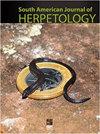Potential Current and Future Distribution of the Andean Toad Rhinella spinulosa Wiegmann, 1834 (Anura: Bufonidae): Is the Species Vulnerable to Climate Change?
IF 0.7
4区 生物学
Q4 ZOOLOGY
引用次数: 0
Abstract
Abstract. Climate change is a global phenomenon that will generate profound changes in biodiversity in the near future. Studies have reported negative impacts of climate change for South American amphibians; however, for Andean species such as Rhinella spinulosa, the potential response to the effects of climate change is unknown. Using ecological niche models, we estimate the potential distribution of R. spinulosa, identifying the environmental variables that explain its distribution and projecting predictions in climate change scenarios to elucidate their impact on the distribution pattern. The results revealed that the variables of elevation (48.7%), mean temperature of the hottest quarter (44.2%), and topographic humidity index (3.2%) were the most important contributors to the model and are predictors of the distribution of R. spinulosa. The most suitable areas for its distribution are its current range, extending to the north, as well as on the western Andean slope and Argentine Patagonia. Predictions for the future (year 2080) under two scenarios (benign and severe) coincide with the distribution predicted for the current one. Climatic conditions will not be considerably different in the distribution area of R. spinulosa, which may be due to the buffer effect of the mountain range. However, freshwater ecosystems will be more at risk from climate change, which could affect the reproductive success and survival of amphibians. Therefore, we recommend evaluating water availability at a local scale to understand the potential changes in the geographic distribution of R. spinulosa. Resumen. El cambio climático es un fenómeno global que podría generar profundos cambios en la biodiversidad en el futuro cercano. Estudios reportan impactos negativos del cambio climático para anfibios sudamericanos, sin embargo, para especies andinas como Rhinella spinulosa, la potencial respuesta de los efectos del cambio climático es desconocida. Usando modelos de nicho ecológico (ENM), nosotros estimamos la distribución potencial de R. spinulosa, identificando las variables ambientales que explican su distribución y proyectando predicciones en escenarios de cambio climático para elucidar su impacto sobre los patrones de distribución. Los resultados revelaron que las variables altitud (48.7%), temperatura media del trimestre más cálido (44,2%) y el índice de humedad topográfica (3,2%) fueron los contribuyentes más importantes al modelo y son predictores de la distribución de R. spinulosa. Las áreas más adecuadas para su distribución es su rango actual, extendiendo su rango hacia el norte, así como en la vertiente occidental de los Andes y la Patagonia Argentina. Las predicciones para el futuro (año 2080) bajo ambos escenarios (benigno y severo) coinciden con la distribución predicha actual. Las condiciones climáticas no serán considerablemente diferentes en el área de distribución de R. spinulosa, lo que puede deberse al efecto amortiguador de la cordillera. Sin embargo, los ecosistemas de agua dulce estarán en mayor riesgo por el cambio climático, que podría afectar el éxito reproductivo y la supervivencia de los anfibios. Por lo tanto, recomendamos evaluar la disponibilidad de agua a escala local para entender cambios potenciales en la distribución geográfica de R. spinulosa.安第斯蟾蜍Rhinella spinulosa Wiegmann, 1834(无尾目:蟾蜍科):物种易受气候变化的影响吗?
摘要。气候变化是一种全球现象,在不久的将来将导致生物多样性的深刻变化。研究报告了气候变化对南美两栖动物的负面影响;然而,对于犀牛等安第斯物种来说,对气候变化影响的潜在反应尚不清楚。使用生态Niche模型,我们估计了刺状芽孢杆菌的潜在分布,确定了解释其分布的环境变量,并预测了气候变化情景中的预测,以阐明它们对分布模式的影响。结果表明,海拔(48.7%)、最热季度平均温度(44.2%)和地形湿度指数(3.2%)等变量是该模型的最重要贡献者,也是刺五加分布的预测因子。最适合其分布的地区是其目前的范围,延伸到北部,以及西安第斯斜坡和阿根廷巴塔哥尼亚。在两种情况(良性和重度)下对未来(2080年)的预测与目前预测的分布相吻合。刺五加分布区的气候条件不会有很大差异,这可能是由于山脉的缓冲作用。然而,淡水生态系统将面临更大的气候变化风险,这可能影响两栖动物的繁殖成功和生存。因此,我们建议在当地范围内评估水的可得性,以了解刺五加地理分布的潜在变化。总结。气候变化是一种全球现象,在不久的将来可能导致生物多样性发生深刻变化。研究报告说,气候变化对南美洲两栖动物产生了负面影响,但对于像刺突犀牛这样的安第斯物种来说,气候变化影响的潜在反应尚不清楚。使用生态位模型(ENM),我们估计了刺突龙的潜在分布,确定了解释其分布的环境变量,并在气候变化情景中预测预测,以阐明其对分布模式的影响。结果表明,海拔(48.7%)、最热季度平均气温(44.2%)和地形湿度指数(3.2%)是该模型的最重要贡献者,也是棘状体分布的预测因子。最适合其分布的地区是其目前的范围,将其范围扩大到北部,以及安第斯山脉和阿根廷巴塔哥尼亚的西坡。在这两种情况(良性和严重)下对未来(2080年)的预测与目前的预测分布相吻合。刺状河分布区的气候条件不会有很大不同,这可能是由于山脉的缓冲作用。然而,气候变化将使淡水生态系统面临更大的风险,这可能会影响两栖动物的繁殖成功和生存。因此,我们建议在地方一级评估水的可用性,以了解刺五加地理分布的潜在变化。
本文章由计算机程序翻译,如有差异,请以英文原文为准。
求助全文
约1分钟内获得全文
求助全文
来源期刊
CiteScore
1.50
自引率
0.00%
发文量
10
期刊介绍:
The South American Journal of Herpetology (SAJH) is an international journal published by the Brazilian Society of Herpetology that aims to provide an effective medium of communication for the international herpetological community. SAJH publishes peer-reviewed original contributions on all subjects related to the biology of amphibians and reptiles, including descriptive, comparative, inferential, and experimental studies and taxa from anywhere in the world, as well as theoretical studies that explore principles and methods.

 求助内容:
求助内容: 应助结果提醒方式:
应助结果提醒方式:


